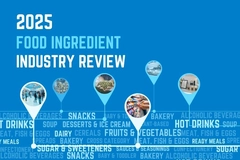
- Industry news
Industry news
- Category news
Category news
- Reports
- Key trends
- Multimedia
- Journal
- Events
- Suppliers
- Home
- Industry news
Industry news
- Category news
Category news
- Reports
- Key trends
- Multimedia
- Events
- Suppliers
Upcycling ingredients: Curbing waste and loss while innovating with taste and texture

23 Mar 2022 --- From plant-based food to infant nutrition and whey protein, the upcycling ingredients space is spurred by consumer demands for environmental sustainability and innovative technology.
FoodIngredientsFirst speaks to a roundtable of experts from Arla Foods Ingredients, Bunge, Merit Functional Foods and Evergrain who delve into how upcycling is changing industry and how compromise is no longer an option for consumers.
“While early adopters of plant-based food and beverages may have been more forgiving of a product’s taste, today the consumer base has exploded – and with that growth has come the expectation of good taste, texture, and nutrition - essentially the ability to move to a plant-based diet without making sacrifices,” says Tara Kozlowich, vice president of marketing, Merit Functional Foods.

“These higher expectations are the driving force behind much of the growth and innovation we’re seeing from CPG companies, as they try to reformulate and grow their plant-based offerings to meet consumer demand.”
 Arla Foods Ingredients reutilizes nutrients from a variety of dairy-based sources, making them available to infant formula manufacturers around the world.Upcycling for circular bioeconomy
Arla Foods Ingredients reutilizes nutrients from a variety of dairy-based sources, making them available to infant formula manufacturers around the world.Upcycling for circular bioeconomy
Meanwhile, Arla Foods Ingredients highlights how upcycling ingredients aids in developing a circular bioeconomy, according to Luis Cubel, vice president, commercial.
“It all began with our founding idea all those years ago: to turn waste whey into animal feed. We now maximize whey and milk ‘streams’ through fractionation and reduce waste by upgrading the resulting side-streams.”
Some of Arla’s side streams are disposed to other companies, enabling them to add more value to their own side streams, such as feed products and biogas materials, Cubel notes.
“We process renewable biological resources - whey and other dairy raw material flows - and convert them into food, feed, bio-based products and bioenergy. Rather than becoming waste or pollution, these flows are reused, repurposed, recycled or upcycled.”
“Experience is everything”
Consumers now have more options than ever for plant-based applications, underscores Mark Stavro, global marketing director, Bunge North America.
It is the experience that companies offer consumers with their products that will set apart the successful brands from their competitors, he adds.
“Right now, in plant-based protein ingredients, experience is everything. Consumers won’t return to a plant-based burger that doesn’t cook, taste, look, and feel like it should.”
“For plant-based meat analogs, the sizzle in the pan, the aroma, and the juiciness and bite of the product all fit into one cohesive experience. For dairy alternatives, producers must be able to meet the consumer’s expectations for creaminess, neutral flavor and color.”
Trends in agriculture and new processing technologies have greatly improved the quality, purity and availability of plant-based ingredients, Stavro notes.
“Even newer entrants, such as fava bean, create interesting possibilities for taste and texture.” Technological developments in plant-based ingredients are driving innovation.
Technological developments in plant-based ingredients are driving innovation.
More than just the food: it’s where it came from
According to Cubel, there is also a growing trend for clean label ingredients.
“Now more than ever, people want to know the truth about where their food comes from and what impact it’s having on the planet,” states Jacqueline Hochreiter, sustainability and marketing director, EverGrain Ingredients.
Though claims such as Non-GMO Project Verified, natural, plant-based are some of the most popular, there are some new claims emerging, such as Upcycled Certified. This is a new certification, recently created by the Upcycled Food Association, with EverGrain being one of the first to enable brands to put this claim on their packaging.
“Many CPG companies are also weaving the stories of the main ingredients in their products into their own marketing – sharing information about their supplier’s sustainability practices and how ingredients are grown, processed, shipped, etc. This transparency helps build brand credibility and trust with consumers,” Kozlowich underscores.
In the plant-based space, traditionally, products simply featured “plant-based protein” descriptors on the packaging, she adds.
“However, consumers are becoming more considerate of the protein options they choose and are now interested in knowing what type of protein is in the product they’re purchasing and where it comes from. That’s why we’re starting to see the specific source – whether that be pea, pumpkin, brown rice, etc. – called out.”
Upcycling for sports nutrition
Whey is no longer viewed as simply a waste product, Cubel underscores.
“Having developed the know-how and technology to enable us to use the same flows to produce high-quality, food-grade whey protein, casein, and lactose, we focus on maximizing value from every dairy stream. By doing this, we have been able to tap into consumer demand for high protein in categories such as sports nutrition.”
Whey proteins can be delivered in many ways, with Arla Foods Ingredients offering ingredients for a range of applications such as beverages solutions, including Lacprodan Clear Shake. The item is described as a clear whey protein isolate, which allows the creation of high-protein, clear, ready-to-drink beverages or shakes with zero protein taste.
Consumers are seeking plant-based products for a variety of reasons, including animal welfare, personal health and sustainability.
Harnessing technology
Key to successful upcycling lies in utilizing extraction and membrane filtration technology to remove undesirable impurities, Kozlowich notes. This leaves a very high concentration of proteins that have maintained their native functionality while free from less desirable sensory properties found in proteins manufactured via traditional processes.
The result is a highly soluble, 90% pea protein with a neutral color and smooth texture that enables formulators to utilize when developing plant-based applications, including dairy alternatives such as cream cheese, cheese, yogurt, and milk, and sports nutrition products like plant-based protein bars and ready-to-mix protein powder, she adds.
With canola protein, proprietary technology creates a clean, functional protein ingredient making it suitable for plant-based protein bars, ready-to-mix protein powder, high-protein pancake mix, egg-free cookies, to name a few. Puratein canola protein has a complementary amino acid profile to pea protein, resulting in boosted nutrition in plant-based food and beverage products.
Opportunities in infant nutrition
In working with technology and upcycling hand in hand, Origin by Arla Foods Ingredients’ milk fractionation technology reduces production complexity and ensures gentler processing of the milk, according to Cubel.
“Our patented milk fractionation process means you can go from milk to infant formula in one step, rather than the current method, which has many processing steps.”
An additional benefit from the milk fractionation process is that the company has been able to separate off a portion of the milk protein casein, which is a co-product from the milk fractionation process, he adds.
“This co-product is a very pure milk protein source, and it opens new markets for us in sports nutrition and medical nutrition. We believe it gives us the opportunity to offer much better quality, particularly from a taste point of view, as well as the option to produce organic options.”
“With this technology, our focus right now is on infant nutrition and in particular, infant formula based on organic milk. What this means is, when a product is created using this technology, manufacturers will have the ability to talk about a much cleaner label and a product that has been much less processed and is therefore truly organic.”
By Andria Kades










